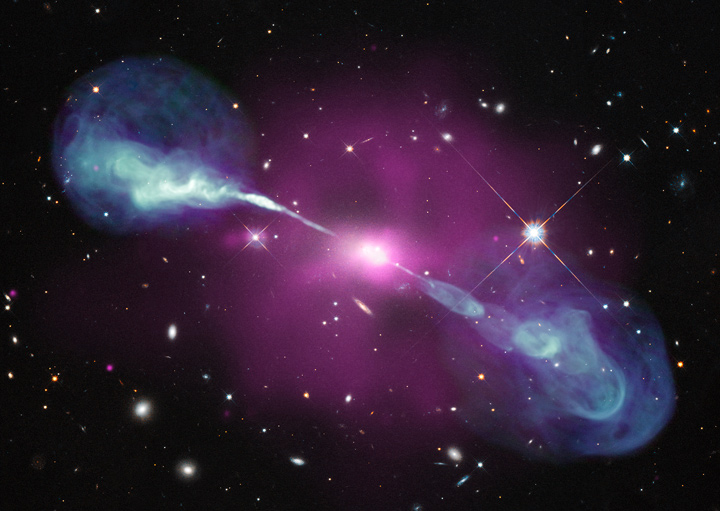Hercules A
About 1.9 billion light years

Image Credit: X-ray: NASA/CXC/SAO, Optical: NASA/STScI, Radio: NSF/NRAO/VLA
Some galaxies are extremely bright in different wavelengths of light. This is because their centers contain a supermassive black hole that is pulling in matter at a prodigious rate. In visible light (colored red, green and blue, with bright galaxies appearing white), Hercules A looks like a typical elliptical galaxy. In X-ray light, however, a giant cloud of multimillion-degree gas (shown in purple) is detected. This gas has been heated by energy generated by the infall of matter into the black hole at the center of Hercules A that is over 1,000 times as massive as the one in the middle of the Milky Way. Radio data (in blue) show jets of particles streaming away from the black hole, spanning a length of almost one million light years.
Listen to audio version (English)
Download high-res image file | Download caption as .zip file
Hércules A - 1,900 millones de años luz de la Tierra
Algunas galaxias son muy brillantes en diferentes longitudes de onda de la luz. Esto se debe a que sus centros contienen un agujero negro supermasivo que hala la materia a un ritmo prodigioso. En luz visible (de color rojo, verde y azul, con las galaxias brillantes apareciendo de color blanco), Hércules A parece una galaxia elíptica típica. En luz de rayos X, sin embargo, se detecta una gigantesca nube de gas de varios multimillones de grados (en púrpura). Este gas ha sido calentado por la energía generada por la caída de materia en el agujero negro en el centro de Hércules A que es más de 1,000 veces más masivo que el que está en el centro de la Vía Láctea. Datos de radio (en azul) muestran chorros de partículas expulsadas del agujero negro, que abarca una longitud de casi un millón de años luz.
Download high-res image file | Download caption as .zip file



